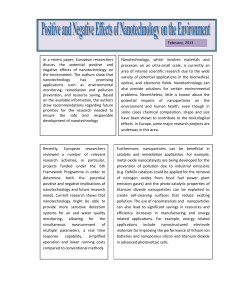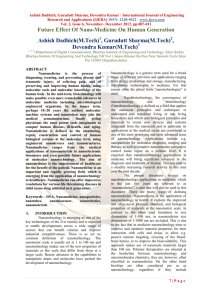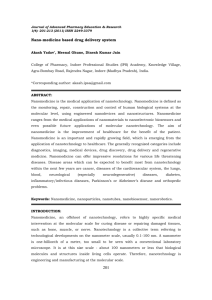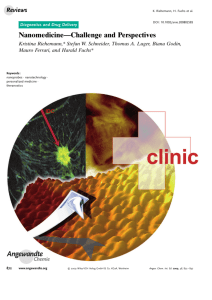Technion Fundamentals of NanoBiotechnology
advertisement
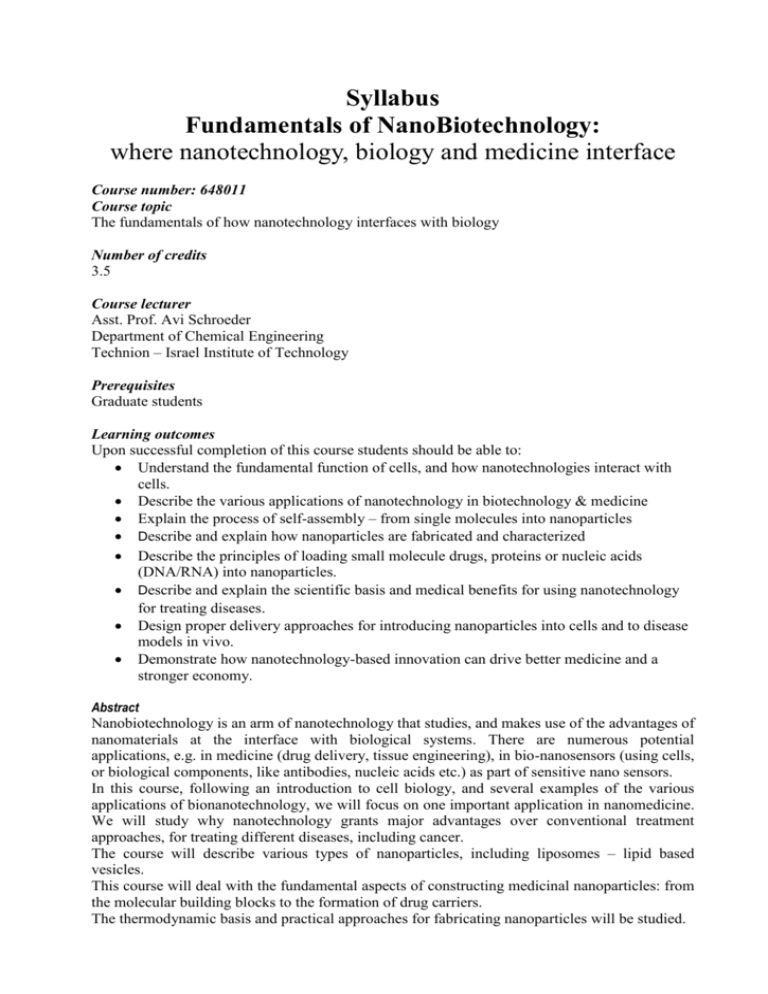
Syllabus Fundamentals of NanoBiotechnology: where nanotechnology, biology and medicine interface Course number: 648011 Course topic The fundamentals of how nanotechnology interfaces with biology Number of credits 3.5 Course lecturer Asst. Prof. Avi Schroeder Department of Chemical Engineering Technion – Israel Institute of Technology Prerequisites Graduate students Learning outcomes Upon successful completion of this course students should be able to: Understand the fundamental function of cells, and how nanotechnologies interact with cells. Describe the various applications of nanotechnology in biotechnology & medicine Explain the process of self-assembly – from single molecules into nanoparticles Describe and explain how nanoparticles are fabricated and characterized Describe the principles of loading small molecule drugs, proteins or nucleic acids (DNA/RNA) into nanoparticles. Describe and explain the scientific basis and medical benefits for using nanotechnology for treating diseases. Design proper delivery approaches for introducing nanoparticles into cells and to disease models in vivo. Demonstrate how nanotechnology-based innovation can drive better medicine and a stronger economy. Abstract Nanobiotechnology is an arm of nanotechnology that studies, and makes use of the advantages of nanomaterials at the interface with biological systems. There are numerous potential applications, e.g. in medicine (drug delivery, tissue engineering), in bio-nanosensors (using cells, or biological components, like antibodies, nucleic acids etc.) as part of sensitive nano sensors. In this course, following an introduction to cell biology, and several examples of the various applications of bionanotechnology, we will focus on one important application in nanomedicine. We will study why nanotechnology grants major advantages over conventional treatment approaches, for treating different diseases, including cancer. The course will describe various types of nanoparticles, including liposomes – lipid based vesicles. This course will deal with the fundamental aspects of constructing medicinal nanoparticles: from the molecular building blocks to the formation of drug carriers. The thermodynamic basis and practical approaches for fabricating nanoparticles will be studied. The course will deal with approaches for loading and delivering drugs and genes to disease sites using nanotechnology. Approaches for targeting drugs to specific organs and to diseased tissues will be described. The application of nanobiotechnology, and specifically, nanomedicine, will be studied. Keywords: Nanotechnology, biology, medicine, cancer Content 1) Fundamentals of cell biology a. Cell types b. Organelles c. The main processes in the life of a cell d. From cells to tissue 2) An introduction to nanobiotechnology, how does nanotechnology interfaces with biology1,2 a. How nanosize affects properties b. Building blocks: lipids, polymers, carbon nanotubes, proteins and DNA c. Self-assembly and the packing parameter4,5 d. Types of nanoparticles 3) Applications of Nanobiotechnology & nanomedicine: a. Nanobiosensors b. Nano-functionalization of surfaces with biomolecules for various applications such as selective recovery of compounds produced in biotechnological processes, and in microfluidic devices c. Tissue engineering with biocompatible nanostructures, soft lithography d. Diagnostic imaging and drug delivery (detailed further on). 4) Mechanism of nanoparticle fabrication6,7 a. Extrusion8 b. Sonication c. Electrospinning 5) Characterizing nanoparticles: a. Electron microscopy b. Dynamic light scattering c. Chromatography 6) Introduction to nanomedicine a. Paul Ehrlich's magic bullet b. Targeting diseased tissue and specific organs in the body: highlighting cancer.9,10 c. The EPR effect d. Evading the immune system: Stealth (PEGylation) e. Stimulating the immune system f. Inside the cell: escaping from the endosome 7) Loading drugs into nanoparticles a. Selecting the proper building blocks for constructing your nanoparticle b. Small molecule drugs c. Nucleic acids (DNA, RNA) 8) Controlled release of drugs from liposomes in disease sites11 a. pH-sensitive nanoparticles b. reduction sensitive nanoparticles c. enzyme-induced activation/release d. using external stimuli to release drugs from nanoparticles. 9) Nanotechnology in the clinic: pro's and con's Teaching methods The course will combine theoretical studies, together with highlighted case studies, that exemplify the fundamental principles. We will take advantage of the filmed nature of the course to add to the course live filming from the lab – to help familiarize the students with the translation of theory into practice. Where necessary, experts from the world will explain their perspective on nanomedicine. The theoretical part of the course is presented in the Moodle learning environment in the form of HTML tutorials. The practical work will include reading materials the students will be expected to deal with for answering questions online, as a basis for continuing to the following lectures. At the completion of the course, the students will be requested to submit an original project in which they design a drug delivery system. A peer review approach for evaluating the projects will be introduced. Assessment The course grade consists of these components: 40% – Knowledge tests with a multiple choice questionnaire 60% – Final Project Recommended reading Biology: Life: The Science of Biology, 7th Edition - W. Purves, D. Sadava, G. Orians, C. Heller NanoBioTechnolgy: Nanobiotechnology: Concepts, Applications and Perspectives Christof M. Niemeyer (Editor), Chad A. Mirkin (Editor) ISBN: 978-3-527-30658-9 1 2 3 4 5 Torchilin, V. P. Recent advances with liposomes as pharmaceutical carriers. Nat Rev Drug Discov 4, 145-160 (2005). Duncan, R. & Gaspar, R. Nanomedicine(s) under the microscope. Mol Pharm 8, 21012141, doi:10.1021/mp200394t (2011). Mouritsen, O. G. Life As a Matter of Fat. The Emerging Science of Lipidomics. (Springer-Verlag, 2005). Israelachvili, J. N. Intermolecular and Surface Forces. 2 edn, (Academic Press, 1992). Kumar, V. V. Complementary molecular shapes and additivity of the packing parameter of lipids. PNAS 88, 444-448 (1991). 6 7 8 9 10 11 Barenholz, Y., Bolotin, E., Cohen, R. & Gabizon, A. Sterically stabilized doxorubicin loaded liposomes (DOXIL): From basics to the clinics. Phosphorus Sulfur and Silicon and the Related Elements 109, 293-296 (1996). Drummond, D. C., Meyer, O., Hong, K., Kirpotin, D. B. & Papahadjopoulos, D. Optimizing liposomes for delivery of chemotherapeutic agents to solid tumors. Pharmacological reviews 51, 691-743 (1999). Clerc, S. G. & Thompson, T. E. A possible mechanism for vesicle formation by extrusion. Biophys J 67, 475-476 (1994). Maeda, H., Wu, J., Sawa, T., Matsumura, Y. & Hori, K. Tumor vascular permeability and the EPR effect in macromolecular therapeutics: a review. J Control Release 65, 271-284 (2000). Torchilin, V. P. & Papisov, M. I. Why do polyethylene glycol-coated liposomes circulate so long? J. Liposome Res. 4, 725-739 (1994). Schroeder, A., Kost, J. & Barenholz, Y. Ultrasound, liposomes, and drug delivery: principles for using ultrasound to control the release of drugs from liposomes. Chem Phys Lipids 162, 1-16 (2009).



